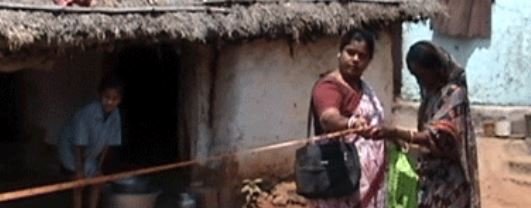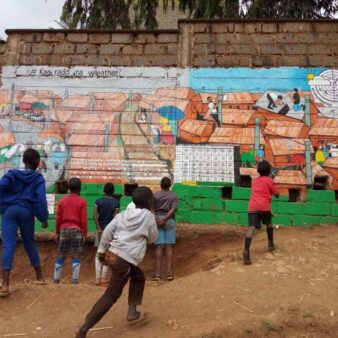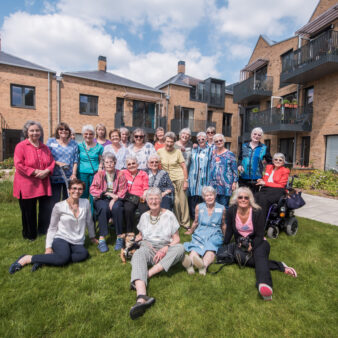Project Description
Aims and Objectives
With the aim to ensure secure housing and infrastructure for the urban poor, the Alliance works to develop urban practices and policies that are inclusive of the poor, and facilitate and demonstrate the effectiveness of bottom-up approaches. It works to produce long-term change, build the capacity of organised communities to stop forced evictions and develop skills and confidence to negotiate with the government and other actors on issues of housing, land, sanitation and basic amenities, giving a central role to women as well as to credit and savings groups (Mahila Milan groups).
Context
The Odisha Alliance is part of the broader Indian Alliance, active in 72 cities in nine Indian states and whose work is internationally recognised. Mahila Milan and Sparc have been working in Odisha since 1999 to facilitate community-driven processes. In India’s cities, the urban poor generally live in informal settlements, where houses are mostly made of either poles and plastic or mud walls and a thatched/plastic sheet roof, which demand repair every year at prohibitive costs. Permanent/stronger houses are not built due to a lack of secure land tenure and of available capital for housing investment. The situation is further aggravated due to regular natural and/or man-made calamities, and evictions driven by the city administration. The housing shortage is very high for those who cannot afford to purchase materials and land at market prices. Odisha is one of the poorest states in India, and urban poverty is estimated to be 42 per cent, much higher than the national average of 30 per cent.
Key features
The approach includes various methodologies such as the formation of savings and credit groups; community-led mapping, surveys and enumerations; exchange amongst communities; building model houses; advocating for alternative tenure options and building community infrastructure and access to services. In addition, it engages with the policy arena through various peer group exchanges, precedence-setting and knowledge-sharing activities, campaigns, partnership building, negotiations with the authorities and undertaking proposals initiated by the Mahila Milan federations of slum dwellers.
The Alliance works to create housing options for the poor on two fronts:
- Through internal resources, including incremental housing programmes and credit-based housing programmes.
- Through government partnerships, including affordable housing schemes implemented by communities, land provision, subsidised housing mechanisms and infrastructure projects.
The housing-related activities are framed and interlinked within the wider work of the Alliance and its partners, which includes:
- Community savings and credit programmes, building financial assets and local capacity.
- Conducting community-led slum surveys and mapping to form a base for building ownership, creating strategies and negotiation.
- Facilitating peer exchanges at the local, regional and national levels so that communities, government officials and NGOs can learn from each other.
- Supporting dialogue and negotiations with relevant authorities, advocating for pro-poor policy changes.
The Alliance works on the basis that change only occurs when the communities are organised, which makes them central to the design and management of the projects. Each community is encouraged to act as its own building centre: the work is carried out by the residents with minimum involvement of external skilled labourers or engineers, to enable communities to participate to a greater extent in urban poor housing schemes. Additionally, direct accountability, engagement and negotiations with communities ensure quality and transparency, reducing corruption and exclusion.
Covering costs
The costs of setting up the project were met with funding provided by SPARC-SSNS (Samudaya Nirman Sahayak, a non-profit company founded by Sparc), SDI, CLIFF, DFID, SIDA, and Homeless International, amongst others.
The broad range of activities developed has the following funding sources:
- Core/staff/architectural expenses: international donors/SPARC.
- Community/federation monitoring expenses: NSDF/SDI/SSNS.
- Credit link for business/entrepreneurship programmes: RMK (Rashtriya Mahila Kosh, an Indian government women’s fund), NSDF and loans from Odisha Mahila Milan and the National Mahila Milan Federation.
- Partnerships with the government in housing schemes: all projects include residents’ contribution and the local/national government counterpart. The percentage of government contribution varies between 50 and 90 per cent of costs, with residents contributing between 10 and 50 per cent.
- Infrastructure projects: 80 per cent of total project costs are covered by the national government (Urban Development Department), 10 per cent by the national/regional government, 10 per cent by UDRC/SSNS, and a revolving fund of 10 per cent (the initial investment provided by residents), which is reinvested on future projects once the works are finished. In some cases, such as the electricity and drainage projects, a contribution from international agencies (DFID) is included.
- Precedent-setting activities for model houses: funding is provided by CLIFF, DFID and Sparc.
- The Alliance funds the initiatives that are not covered by any other funding scheme, including incremental housing projects and credit-based housing projects, which are also supported by national or local federations and residents’ contributions.
Impact
- The Alliance has mobilised about 10,000 members in the area, who organised themselves to be partners in developing affordable and effective solutions to their problems, engaging in dialogue and collaboration with authorities, paving the way to scale up programmes and policies.
- After 15 years of negotiations, participatory processes are now mandatory for government projects. The bill for land titling/property rights for slum dwellers has been developed and is due to be passed in the Assembly and a slum policy is also in place. Slum dwellers have basic rights to livelihoods, land and housing at both the Odisha state and national levels. Land titling projects are now reaching more than 3,000 families.
- The Alliance has worked with local federations for housing savings. The Mahila Milan women’s collective channels funds to more than 5,000 families for business, housing improvement, sanitation, etc.
- As of 2013, 60 low-cost model houses have been built and four community toilets and 50 individual toilets are being built. Around 400 houses are at different stages of construction, in partnership with national government housing schemes. Four slums have been connected to the water network – one has received sewerage and another area has obtained drainage. 80,000 families have been surveyed.
Why is it innovative?
- Alliance model, with people-led processes, that creates and expands options for change and further learning and practice.
- Being a mission-driven, decentralised, bottom-up, women-led organisational process of the urban poor, challenging normal patterns so as to reach the bottom of the pyramid, whilst utilising well recognized methodologies for community-driven development.
- Tackling various issues affecting residents of informal settlements: access to services and infrastructure, housing and land tenure, access to credit, etc. At the community level, it offers options for different income groups.
- Using pilot houses as catalysts for a broader change of practices, by engaging with government and financial actors. These are socially, culturally, economically and spatially viable solutions, many being resistant to natural disasters.
- Community mapping through GPS/MIS technologies at a city scale, which has been highlighted as a successful case study for other states under national government programmes.
- The scaling-up process is bottom-up, through community exchanges and dialogue between communities and other actors.
What is the environmental impact?
- Each community is encouraged to act as its own ‘building centre’, using locally available skills and materials. Construction practices include the re-use and recycling of materials for filling, flooring, etc. In the construction processes, laterite stones are used (and fly ash bricks, where possible), giving more strength to the structure than mud, saving space and being more environmentally friendly than if using burnt brick.
- Some infrastructure projects, which are in the process of being taken up, include proposals to have ground water recharging.
- The work on water and sanitation infrastructure aims to reduce open defecation practices, with additional health and environmental benefits.
Is it financially sustainable?
- Funding comes from a combination of loans and subsidies, including government and Alliance partners’ funding. The financing mechanism is fundamentally and primarily dependent on community-NGO support, sustained by the communities through savings schemes with the help of NGOs, and further assisted by land provision by the respective city administration. The community mechanism is already in place, and is evolving so as to involve more partners and stakeholders.
- The initiative has an impact on the wealth of the community by encouraging daily savings, increasing financial assets. Additionally, Mahila Milan provides loans to start businesses and entrepreneurial activities for families with unemployed members struggling to repay loans for those who are unemployed.
- Housing construction is taken up with minimum skilled labourer or engineers, and residents also work as community contractors for other similar communities, or catering to the middle or upper class population. By building stronger houses, repair costs are reduced, enabling these resources to be available for other purposes, also providing durability and protection for residents.
- In addition to cutting labour costs, alternative construction practices are used to reduce the cost of the housing units. These include a combined staircase and common wall between houses; arch-shaped doors and windows instead of concrete/wooden frames or lintels; cemented frames to reduce the cost of steel or wood, etc. The average cost of a model house is approximately US$2000, significantly lower than conventional housing provided through government programmes (around US$3000 per house).
What is the social impact?
- The Alliance works to empower residents around issues of housing, land, sanitation and basic amenities. Housing initiatives are seen as means of mobilisation. The initiative aims to move towards people-led projects, by making technocrats work together with the community for feasible housing and settlement design as per the people’s choice. Additionally, partnerships with formal structures including regional and national governments have been created, and there is a high level of confidence among members, whose voices are heard in the process of finding adequate solutions and improving living conditions. These successful partnerships meant that regular contractors which had previously rejected this type of work are now involved.
- The approach works to encourage the development of localised, yet alternative and innovative solutions, learning through exchanges, community dialogues and mobilising instruments to create social and technical capital in the form of community-based, women-centred building and resource centres. It also aims to build relationships of trust, and to address unequal power relations between formal and informal entities (i.e. between the State, NGOs and slums), avoiding male domination and the power of experts through mutual respect and equality.
- Capacity building for the poor is carried out in various areas (finances, information, organisation, negotiation, planning and execution), so that people can take ownership of the process. Area Resource Centres have been set up, which serve as a meeting place and a base for community-building activities.
- The Alliance works as the agency for city scale urban poor surveys and planning and community-led GPS mapping, with 70 per cent of the work carried out by slum residents, creating people’s ownership over their data and maps.
- The strategy starts with the poorest of the poor, reducing the social divide. Women’s participation is central: 90 per cent of Mahila Milan federation and UDRC members are women, who are the drivers of the process.
Barriers
- Bureaucratic delays and other forms of pressure are handled through direct dialogue with communities and other stakeholders in a transparent manner as routine work.
- Land status is complex, land is scarce and this is a major hurdle for projects to be implemented and transferred. Negotiations through the current bill on property rights and alternative design and construction methods aim to mitigate this problem.
- The integrity of community leaders, and the risk of them being co-opted by other interest groups, constitutes a challenge for the sustainability of the process. This is dealt with by supporting leadership structures rather than personal leadership, and creating mechanisms where leaders are directly accountable to their communities.
- Lack of credit for the improvement of living conditions of the people in need. The Alliance partners act as a link between the communities and financial markets, providing mechanisms to serve these sectors and provide access to credit.
- Environmentally-friendly and sustainable energy sources are usually capital-intensive and therefore unaffordable for these sectors. Feasible renewable options for cooking and electricity are to be explored, considering subsidies as an option.
Lessons Learned
- Urban projects for the poor are complex, and need to be addressed from a socio-political rather than technical perspective.
- There is no standard scheme to fit all: the project aims at creating options for the different needs of different groups.
- Continuous engagement with government and formal stakeholders is needed to build people’s capacities, challenging the regular format of mainstream project implementation and moving towards promoting people-led processes.
- Micro-financing for very poor families does not work well in housing projects, as they get indebted and land is mortgaged to lenders, and therefore should not be encouraged.
- Community and women’s leadership is key to negotiation, and for projects to work in the interest of the community.
- The low-cost self-help housing model costs comparatively less than government scheme housing and, although effective, requires a greater time investment, as it considers families’ financial capacity and the contribution of their labour.
Evaluation
Monitoring and evaluation (M&E) happens at four levels: 1) through community committees; 2) an Alliance M&E team; 3) regular M&E process by Urban Local Bodies (ULBs) and corporations on progress, billing, expenses, materials and labour management; 4) from the national government, a central audit team carries out M&E with communities, almost every quarter to six months.
Transfer
Bottom-up scaling up processes are at the core of the work of the Alliance in Odisha. Sixty model houses have been developed and the approach is in the process of being scaled up, to reach an additional 400 families in collaboration with government housing schemes. Five thousand families are benefiting from Mahila Milan loans.
The regional federation has expanded its base to neighbouring states and 60 cities are now under the fold of Mahila Milan. The government of Odisha wants to expand this to all ULBs, taking these projects as learning points for all cities/towns.
The wider Indian Alliance has been a pioneer in establishing horizontal exchanges. For the last five years it has conducted exchange programmes, nearly six times a year, between government, communities and members of the federation in different states.
The project has been visited by other communities as well as by public authorities.
The community-led mapping through new technologies at a city scale has been highlighted as a successful case study for other states under national government programmes.
The Alliance’s activities are regularly presented as case studies, and university students and interns from ASF, KRVIA (Kamla Raheja Vidyanithi Institute of Architecture, India), CEPT (Centre for Environmental Planning and Technology, India) and Sweden are regularly exposed to UDRC Housing initiatives. Oxford Brookes University had been working on a community-led proposal on Penthakata slum.



